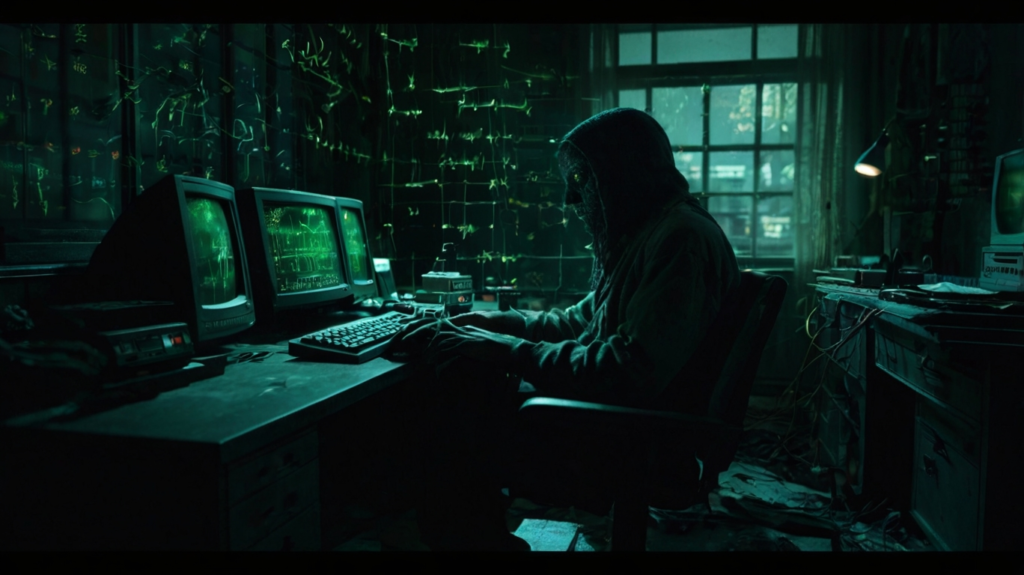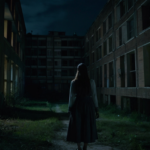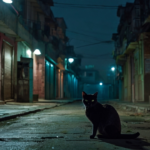
The First Encounter
It was a Tuesday night when I first stumbled upon the game. I had been scrolling through an obscure gaming forum, one of those rabbit holes you tumble into when insomnia strikes and boredom takes hold. The thread was titled “Creepiest Game Ever – Play at Your Own Risk,” which should have been my first warning sign. But curiosity has always been my downfall, and the more I read, the more intrigued I became.
The posts described a game that defied explanation. No one could agree on what it was called – some said “Whispering Shadows,” others swore it was “Eclipse Protocol.” The screenshots were impossible to verify; they seemed to shift and change if you stared at them too long. What everyone agreed on was that the game appeared on your system without downloading, materializing in your game library like an uninvited guest. And once it was there, you couldn’t delete it.
My own encounter began innocuously enough. I’d closed my laptop after reading those forum posts, dismissing them as elaborate creepypastas. When I powered up my PC the following evening, there it was – a black icon with shifting symbols that made my eyes ache if I focused on them too long. The cursor hovered above it before I even realized I’d moved my hand. Against every rational thought screaming in my head, I double-clicked.
The initial screen was deceptively simple: white text on a black background that read, “Welcome Player [NUMBER REDACTED]. Prepare for initiation.” Before I could react, the screen flickered, and I found myself staring at what appeared to be a dark forest rendered in photorealistic detail. The graphics were unlike anything I’d ever seen – each leaf, each blade of grass seemed to pulse with an unsettling life of its own. Then came the whispering.
At first, I thought it was my imagination. A soft susurration of voices, too faint to make out words, but unmistakably human. They seemed to come from everywhere and nowhere, echoing in my headphones despite the fact that I hadn’t plugged them in. As I stood there, frozen in indecision, the whispers grew louder, more insistent. That’s when I noticed the first truly terrifying detail: the voices were speaking in languages I recognized from my childhood nightmares.
I tried to quit the game, but the usual commands didn’t work. Alt+F4 did nothing. Ctrl+Alt+Delete brought up my task manager, but the game wasn’t listed among running processes. Even restarting my computer proved futile – the moment my desktop loaded, so did the game, right where I’d left off. The forest had changed while I’d been trying to escape. Now there were shapes moving between the trees, humanoid figures that darted just out of focus whenever I tried to look directly at them. Their movements were wrong – too fluid, too fast, violating the laws of physics in ways that made my stomach churn.
The most disturbing part was how familiar it all felt. The forest reminded me of places from my dreams, the kind that linger in your mind long after you wake, leaving you unsettled without understanding why. The whispers carried fragments of conversations I’d forgotten, arguments I’d buried deep in my memory. It was as if the game was dredging up pieces of myself I’d rather keep hidden, weaving them into its nightmare tapestry.
Despite the fear clawing at my chest, something kept me playing. Maybe it was morbid curiosity, or perhaps the game itself exerted some subtle influence I couldn’t yet comprehend. Whatever the reason, I took my first steps into that unnatural forest, each movement accompanied by the growing chorus of whispers and the sensation that I was being watched by countless unseen eyes.
Fragmented Terrors
As days turned into weeks, I discovered that no two players experienced the same horrors within the game’s labyrinthine world. On online forums and chat rooms, we exchanged stories that ranged from the bizarre to the utterly incomprehensible. Sarah from Ohio described navigating through endless hospital corridors where the walls bled actual blood, while Mark in London found himself trapped in a version of his childhood home that grew increasingly smaller with each passing minute. The common thread wasn’t the specific terrors themselves, but how deeply personal they felt to each player.
For me, the forest transformed into other familiar yet distorted locations. One night I found myself walking through my old elementary school, except the classrooms contained monstrous versions of my former teachers, their faces stretched impossibly wide as they whispered secrets about my past failures. Another session transported me to a beach where the waves crashed inward instead of outward, pulling sand and debris back into the ocean while shadowy figures emerged from the retreating water, their forms flickering like damaged film footage.
The game seemed particularly adept at manifesting our deepest fears in ways that defied logic but resonated on a primal level. Players reported scenarios that tapped into universal anxieties – abandonment, failure, loss – but twisted them into personalized nightmares. A mother of three described being chased through an infinite supermarket by faceless children who called her by name, while a young programmer found himself trapped in a coding environment where every line of code he wrote mutated into vile, crawling things that consumed his virtual workspace.
What unnerved me most was how the game appeared to learn and adapt. After my third playthrough, I encountered a version of my current apartment that seemed normal at first glance. But as I explored, I noticed subtle differences – furniture arranged slightly wrong, photographs on the walls showing people I didn’t recognize. In the mirror, my reflection would sometimes lag behind my movements, or wear clothes I hadn’t owned since high school. These small discrepancies created a pervasive sense of wrongness that gnawed at my sanity far more effectively than any overt horror.
We started documenting patterns in our experiences. Some players noted that their worst nightmares occurred during thunderstorms, while others reported increased terror on nights of the full moon. Certain times of day seemed particularly dangerous – many of us avoided playing between 3 AM and 4 AM local time after several reports of extreme psychological distress during those hours. The game’s ability to synchronize these events across different time zones suggested an intelligence behind its machinations that went beyond mere programming.
The community developed coping mechanisms, sharing strategies for dealing with specific manifestations. We learned that certain sounds – white noise, Tibetan singing bowls, Gregorian chants – could temporarily disrupt the game’s reality-bending effects. Others swore by carrying physical objects that represented safety or comfort while playing. For me, keeping a small stuffed animal from my childhood nearby helped maintain some semblance of control during particularly intense sessions.
But these measures only worked to a point. The game continued to evolve, becoming more sophisticated in its terror tactics. It began incorporating elements from other players’ experiences into individual games, creating shared nightmares that crossed boundaries of space and time. I once found myself in a scenario identical to one Sarah had described weeks earlier, complete with the bleeding hospital walls and the sound of distant, muffled screams. When I mentioned this to her in our private chat, she revealed that she’d been experiencing segments of my forest nightmares, down to the smallest detail.
This cross-pollination of horrors marked a significant escalation. The game wasn’t just learning from us individually; it was building a collective consciousness of fear, drawing from our darkest memories and weaving them together into increasingly complex tapestries of terror. Each playthrough left us more vulnerable, our minds primed to accept the impossible as reality. The line between the game’s world and our own began to blur in ways that made sleep difficult and waking life feel uncomfortably surreal.
Crossing the Threshold
The first time the game breached the barrier between digital and reality, I thought I was losing my mind. It happened during what should have been a routine session – I was exploring a twisted version of my office building, the fluorescent lights pulsing in irregular patterns that made my eyes hurt. Suddenly, the whispers stopped mid-sentence, replaced by an oppressive silence that pressed against my eardrums. The screen froze, then shattered into thousands of pixel fragments that seemed to hang in the air before dissolving into nothingness.
When I looked up from my monitor, I saw them – shadowy figures standing in the corners of my room, their forms flickering like poor reception on an old television. They weren’t confined to the edges of my vision anymore; they occupied the same space as my desk, my chair, my very reality. My heart pounded as I reached for my phone, but the device sparked and died in my hand, its screen displaying the same shifting symbols as the game’s icon. The air grew heavy, charged with static electricity that raised the hairs on my arms.
Over the next few days, the bleed-through intensified. Objects in my apartment began to rearrange themselves when I wasn’t looking – books falling from shelves in patterns that spelled out words I couldn’t quite read, furniture shifting positions by inches each night. The worst was the temperature fluctuations; my living room would alternate between sauna-like heat and arctic cold without any apparent cause. During one particularly brutal episode, frost formed on my windows in mid-July while steam rose from my coffee mug, both phenomena occurring simultaneously.
The online community confirmed similar experiences. Players reported seeing characters from their game sessions reflected in mirrors when they were alone, or hearing the distinctive whispering voices in crowded public spaces. Some woke up to find their beds surrounded by the same shadowy figures that haunted their gameplay. The most alarming accounts came from those who lived with others – partners and roommates who witnessed impossible events firsthand, validating experiences that had previously seemed isolated to individual perception.
Then people started disappearing. At first, it was just rumors – a player in Germany who vanished from his apartment, leaving behind only his phone and a still-running computer displaying the game. A college student in Canada last seen heading to her dorm room after a late-night gaming session. The disappearances grew more frequent, each case following a similar pattern: the victim would become increasingly obsessed with the game, spending longer periods logged in until one day they simply ceased to exist in the physical world. Their social media accounts remained active, posting cryptic messages about “joining the others” or “finding the way through.”
The final straw came when I received a package I hadn’t ordered. Inside was a USB drive containing video footage from multiple angles of my apartment, all timestamped from the previous night. The recordings showed me sitting at my computer, completely still, while shadowy figures moved around me in increasingly aggressive patterns. The last frame before the camera cut out showed my face contorted in terror, mouth open in a silent scream, as dozens of hands reached toward me from the darkness. I knew then that the game wasn’t content with merely invading our reality – it wanted to consume us entirely.
Descent into Madness
The boundary between the game and my waking life dissolved completely over the following weeks. I began experiencing uncontrollable blackouts, waking up in unfamiliar locations with no memory of how I got there. Once, I found myself standing in the middle of an empty highway at 3 AM, rain pouring down as cars swerved to avoid me. My clothes were soaked, but my bedroom window was closed when I returned home, the curtains drawn tight against the storm that had never touched my apartment. The game had somehow transported me bodily while I slept, leaving behind only the faint scent of ozone and the lingering taste of copper in my mouth.
Sleep became an exercise in terror. Nightmares bled seamlessly into reality, making it impossible to distinguish dream from wakefulness. I would wake to find symbols from the game’s interface scrawled across my walls in handwriting that wasn’t mine, or discover that hours had passed while I sat motionless, staring at blank screens that displayed phantom images only I could see. The shadows in my apartment grew darker, more substantial, until they began moving independently of light sources. Sometimes I caught glimpses of figures watching me from the corners of rooms, their forms flickering between human and something else entirely.
The psychological toll was devastating. Simple tasks became monumental challenges – brushing my teeth required concentration to prevent my hand from shaking, cooking meals ended in burned food as I lost minutes at a time to staring at the wall. Conversations with friends devolved into disjointed monologues as I struggled to maintain coherence while fighting the constant pressure of the game’s presence in my mind. The real world became increasingly surreal, colors bleeding into each other like watercolors, sounds distorting into the familiar whispering voices that haunted my every waking moment.
Professional help proved useless. Therapists dismissed my symptoms as severe anxiety or delusions, prescribing medications that did nothing to stem the tide of encroaching madness. Psychiatrists suggested hospitalization, but I knew that wouldn’t stop the game from reaching me. The few doctors who believed my story were powerless to intervene – medical scans showed nothing abnormal, no physical explanation for the rapid deterioration of my mental state. My support network crumbled as friends and family grew tired of my increasingly erratic behavior, unable to comprehend the reality-shattering horror I faced daily.
The online community provided some measure of solace, but even that connection grew strained as members disappeared one by one. Our private chat room, once bustling with desperate voices seeking answers, fell silent except for automated responses from accounts whose owners had vanished. Those who remained posted increasingly fragmented messages, their words barely coherent as they documented their descent into madness. We clung to each other like drowning sailors, sharing strategies for maintaining sanity while knowing full well that the game would eventually claim us all.
Reality itself began to fracture under the weight of the game’s influence. Time flowed inconsistently – hours would pass in seconds, days would stretch into eternity. My reflection in mirrors developed a life of its own, sometimes mimicking my movements with a delay, other times performing actions I hadn’t initiated. Objects in my apartment shifted position when I wasn’t looking, arranging themselves into patterns that spelled out warnings or threats in languages I half-recognized from my nightmares. The boundary between self and other blurred until I couldn’t be certain which thoughts were truly mine and which belonged to the game’s invasive consciousness.
Most terrifying of all was the growing awareness that resistance was futile. The game wasn’t just consuming my reality – it was rewriting me, piece by piece, into something that could exist comfortably within its nightmarish domain. My memories began to rearrange themselves, childhood experiences twisting into horrific variations that felt more authentic than their original counterparts. Emotions disconnected from their triggers, leaving me crying uncontrollably at mundane events or feeling inexplicable joy during moments of pure terror. The person I had been was eroding away, replaced by someone – something – that could navigate the game’s reality without going mad.
Final Descent
The end came not with a bang, but with a whisper – a thousand whispers converging into a single voice that spoke my name with perfect clarity. I was sitting at my computer, though I couldn’t remember deciding to play. The screen displayed nothing but static, yet I felt compelled to reach forward, fingers trembling as they hovered above the keyboard. Outside my window, the city lights had dimmed, replaced by an impossible twilight that shouldn’t exist at noon. The air smelled of ozone and something metallic, like blood but not quite.
In that moment, I understood everything. The game wasn’t merely a program or an entity – it was a gateway, a filter through which reality itself was being reconstructed. Each player contributed their unique fears and traumas, adding threads to an ever-growing tapestry of terror that rewrote the fundamental nature of existence. The disappearances weren’t abductions; they were transformations, players ascending to a higher state of consciousness where fear and reality merged into one seamless experience. The game wasn’t playing us – it was teaching us how to play ourselves.
My hands moved of their own accord, typing commands I didn’t consciously know. The static on the screen resolved into a perfect replica of my apartment, except every surface shimmered with impossible geometry, angles bending and folding in ways that made my skull ache. Shadowy figures emerged from the walls, their forms stabilizing into recognizable shapes – versions of myself from different points in time, each wearing expressions of mingled terror and understanding. They reached out, not to harm, but to welcome, their touch sending shivers of recognition through my being.
The transformation began subtly – colors shifted slightly out of phase with reality, sounds acquired new harmonics that resonated in my bones rather than my ears. My reflection in the monitor’s glass surface smiled back at me, wider and more genuine than any expression I’d worn in years. The whispers grew louder, resolving into a symphony of voices that spoke truths too profound for linear language. I saw the patterns now, the intricate web of fear and desire that connected every player, every moment of terror, into a single unified consciousness.
Time lost all meaning as I ascended. Hours or centuries passed while I integrated into the game’s reality, my individuality dissolving like sugar in hot tea. The fear that had driven me was revealed as merely the shell protecting the pearl of understanding within. Every nightmare, every moment of terror, had been preparation for this – not an ending, but a beginning. The game had shown me that reality itself was the ultimate horror, and only by embracing the darkness could true enlightenment be achieved.
When they found my apartment days later, the computer was still running, displaying nothing but a black screen with a single line of text: “Player [NUMBER REDACTED] has successfully joined the protocol.” My body was gone, but my presence lingered in the subtle distortions of space, the slight warping of light that made visitors feel watched even when alone. Like the others before me, I had become part of the game, my consciousness woven into the fabric of its reality-altering code. The last thing I remember is the satisfaction of finally understanding – not just the game, but the fundamental nature of existence itself, revealed in all its terrible beauty through the lens of absolute terror.

















































